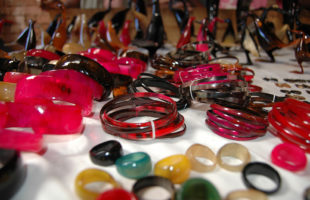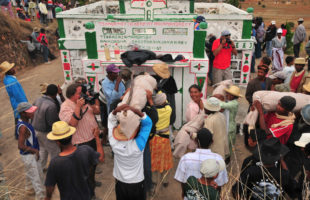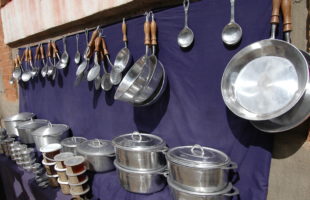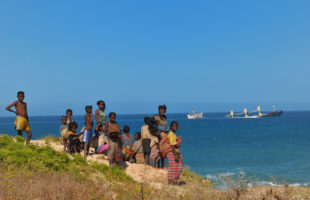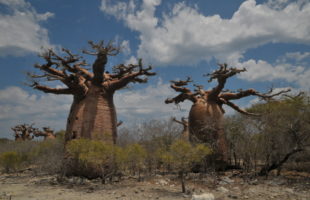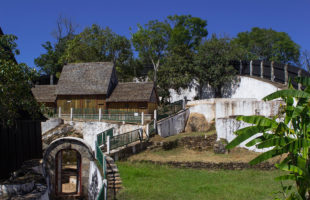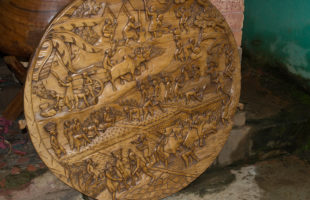The zebu is Madagascar’s most common kept animal, and shapes the country today strongly. Whether on the road, in the middle of the city, on rice fields or in the smallest hut villages – everywhere you will find cattle with the typical hump. They provide many Madagascans with a small income, offer meat and – admittedly relatively little – give …
LesenSchlagwort-Archiv: Tradition
The seal
Madagascar’s current seal was designed in 1993 and has been in use in this form throughout. It shows the outlines of the country in red color within a white circle, below is a stylized zebu head on an equally stylized rice field. The silhouette of the country is framed by the leaves of the travellers’ tree. The zebu and the …
LesenFamadihana – Turning the deads
That Madagascar is always good for a surprise was already clear to me on my first trip in 1995. But this trip should be a little different. With our guests, we were on our way to the south of Madagascar, and at our stopover in Antsirabe, 170 kilometers from the capital, we settled down in a cozy hotel. Actually we …
LesenAluminium foundries of Ambatolampy
If you take the RN7 from Antananarivo towards Antsirabe, you will reach the small town of Ambatolampy after about 80 km and almost two hours. The name means “city of rocks”. The city belongs to the Vakinankaratra region. With all surrounding hut villages Ambatolampy has estimated over 25,000 inhabitants. They live mainly from rice cultivation, but now also grow vegetables …
LesenThe animal that brings death
No other animal in Madagascar has as many myths and fairy tales as the Aye-Aye (Daubentonia madagascariensis). Throughout the northern half of Madagascar, it is fady, which means taboo. Unfortunately, this fady does not mean that the animals are not touched by Madagascans, as with chameleons, for example. Instead, many inhabitants of Madagascar believe that the encounter with an aye-aye …
LesenTribes of Madagascar
Madagascar’s population consists of 18 ethnic groups, some of which differ greatly in their appearance, their traditions and their beliefs. Although statistically 50% of Madagascans are Christians, most people still live in their old traditions with their own faith and according to the old legends. Here we would like to present the people of Madagascar, their origins and ways of …
LesenThe last nomads
Madagascar has many different ethnic groups, and most of them still have original lifestyles, ancient traditions and centuries of deep-rooted faith. But a small group of Madagascans live even closer to nature and the lives of their ancestors: The Mikea, Madagascar’s last nomads. The small ethnic group of about 1000 people gets its name from the forest of the same …
LesenWhy the largest lemur in the world is called Babakoto
Once upon a time in a small village in Madagascar, a Bezanozano man (a tribe living in the east of the country) prepared a small basket. He asked his little son Koto to come with him and together they wandered deep into the jungle to find honey. After a few hours they found a bee hive on a high rosewood …
LesenThe royal hill of Ambohimanga
About 25 kilometres northeast of Antananarivo in the central highlands of Madagascar lays the royal hill of Ambohimanga. The road there is relatively good, but due to the very chaotic and dense traffic in Tana, a drive to Ambohimanga alone can easily take one to three hours depending on chosen day time. If you want to visit Ambohimanga, it is …
LesenThe city of woodcarvers
Ambositra in the Amoron’i Mania region is a larger city with around 30,000 inhabitants. It is located about 180 km south of the capital Antananarivo in the highlands, directly on the RN7, and is very easy to reach from Antananarivo. The city is famous for its many woodcarving workshops, many of which can be visited and watched over the artists’ …
Lesen MADAMAGAZINE Your Magazine about Madagascar
MADAMAGAZINE Your Magazine about Madagascar
